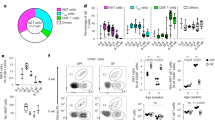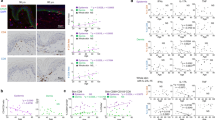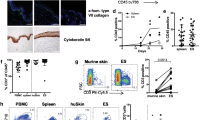Abstract
The major histocompatibility or H–2 complex of the mouse is divided into five regions (K, I, S, G and D)1. Genes in the I region regulate immune responses2. The I region has several subregions which are designated I–A, I–B, I–J, I–E and I–C. The I–A and I–E subregions also code for a set of serologically detected cell-surface alloantigens, designated Ia antigens3. The relationship between the genes regulating the immune response and those encoding the serologically detectable alloantigens is still unknown. A number of species including man, rats and guinea pigs contain genetic regions apparently equivalent to the murine I region. Ia molecules are integral cell-surface glycoproteins that consist of two subunits of approximate molecular weights 35,000 (α) and 28,000 (β). Unlike the classical transplantation antigens which are present on almost all cells, the Ia antigens are found primarily on cells of the immune system—lymphocytes and macrophages4–6. A notable exception has been the demonstration of Ia antigens in mice, or Ia-like antigens in other mammals, on epidermal cells6–13. There is controversy about the numbers of Ia-positive cells in the epidermis. Fluorescence studies in humans11,12, guinea pigs14 and mice15 indicate that only about 5% of epidermal cells are Ia positive. These cells were identified by morphological criteria as the macrophage-like Langerhans cells. However, cytotoxicity studies in mice using anti-Ia sera indicate that a majority of epidermal cells (up to 90%) are Ia positive6–8. The reason for this discrepancy is not known. Here we demonstrate that the epidermal Ia molecules are synthesised by bone marrow-derived cells, presumably Langerhans cells.
This is a preview of subscription content, access via your institution
Access options
Subscribe to this journal
Receive 51 print issues and online access
$199.00 per year
only $3.90 per issue
Buy this article
- Purchase on Springer Link
- Instant access to full article PDF
Prices may be subject to local taxes which are calculated during checkout
Similar content being viewed by others
References
Klein, J. Biology of the Mouse Histocompatibility-2 Complex, 389–489 (Springer, New York, 1975).
Shreffler, D. C. & David, C. S. Adv. Immun. 20, 125–195 (1975).
Murphy, D. B., Herzenberg, L. A., Okumura, K., Herzenberg, L. A. & McDevitt, H. O. J. exp. Med. 144, 699–712 (1976).
Hauptfeld, V., Hauptfeld, M. & Klein, J. J. Immun. 113, 181–188 (1974).
Colombani, J., Colombani, M., Shreffler, D. C. & David, C. Tissue Antigens 7, 74–85 (1976).
Hammerling, G. J., Mauve, G., Goldberg, E. & McDevitt, H. O. Immunogenetics 1, 428–437 (1975).
Klein, J., Geib, R., Chiang, C. & Hauptfeld, V. J. exp. Med. 143, 1439–1452 (1976).
Krco, C. J., Steinmuller, D. & David, C. S. Cell. Immun. 46, 239–246 (1979).
Delovitch, T. & McDevitt, H. O. Immunogenetics 2, 39–52 (1975).
Frelinger, J. G., Wettstein, P. J., Frelinger, J. A. & Hood, L. Immunogenetics 6, 125–135 (1978).
Klareskog, L., Tjerlund, U.M., Forsum, U. & Peterson, P.A. Nature 268, 248–250 (1977).
Rowden, G., Lewis, M. G. & Sullivan, A. K. Nature 268, 247–248 (1977).
Winman, K. et al. Nature 276, 711–713 (1977).
Stingl, G., Katz, S. I., Shevach, E. M., Wolff-Schreiner, E. & Green, I. J. Immun. 120, 570–578 (1978).
Rowden, G., Phillips, T. M. & Delovitch, T. L. Immunogenetics 7, 465–478 (1978).
Stingl, G., Katz, S. I., Clement, L., Green, I. & Shevach, E. M. J. Immun. 121, 2005–2013 (1978).
Prunieras, M. J. invest. Derm. 52, 1–17 (1969).
Silderberg-Sinakin, I., Thorbecke, G. J., Baer, R. L., Rosenthal, S. A. & Berezonsky, V. Cell. Immun. 25, 137–151 (1976).
Schwartz, R. A., Yano, A., Stimpfling, J. H. & Paul, W.E. J. exp. Med. 149, 40–57 (1979).
Oi, V. T., Jones, P. P., Goding, J. W., Herzenberg, L. A. & Herzenberg, L. A. in Current Topics in Microbiology and Immunology Vol. V, 81 (Springer, New York, 1978).
Von Boehmer, H., Sprent, J. & Nabholz, M. J. exp. Med. 141, 322–334 (1975).
Author information
Authors and Affiliations
Rights and permissions
About this article
Cite this article
Frelinger, J., Hood, L., Hill, S. et al. Mouse epidermal Ia molecules have a bone marrow origin. Nature 282, 321–323 (1979). https://doi.org/10.1038/282321a0
Received:
Accepted:
Issue Date:
DOI: https://doi.org/10.1038/282321a0
This article is cited by
-
STR typing of skin swabs from individuals after an allogeneic hematopoietic stem cell transplantation
International Journal of Legal Medicine (2023)
-
Irritierende Ergebnisse einer DNA-Analyse aus Mischspuren
Rechtsmedizin (2017)
-
Development of the prenatal cutaneous antigen‐presenting cell network
Immunology & Cell Biology (2010)
-
The evolving function of Langerhans cells in adaptive skin immunity
Immunology & Cell Biology (2010)
-
Ontogeny and homeostasis of Langerhans cells
Immunology & Cell Biology (2010)
Comments
By submitting a comment you agree to abide by our Terms and Community Guidelines. If you find something abusive or that does not comply with our terms or guidelines please flag it as inappropriate.



